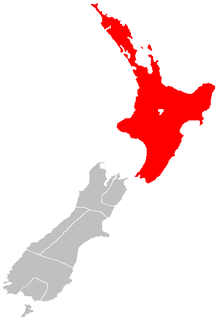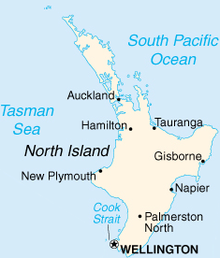North Island
The North Island, also officially named Te Ika-a-Māui,[1] is one of the two main islands of New Zealand, separated from the larger but much less populous South Island by the Cook Strait. The island's area is 113,729 square kilometres (43,911 sq mi),[2] making it the world's 14th-largest island. It has a population of 3,925,800 (June 2021),[3] accounting for approximately 77% of the total residents of New Zealand.[4]
Twelve main urban areas (half of them officially cities) are in the North Island. From north to south, they are Whangārei, Auckland, Hamilton, Tauranga, Rotorua, Gisborne, New Plymouth, Napier, Hastings, Whanganui, Palmerston North, and New Zealand's capital city Wellington, which is located at the south-west tip of the island.
Although the island has been known as the North Island for many years,[5] in 2009 the New Zealand Geographic Board found that, along with the South Island, the North Island had no official name.[6] After a public consultation, the board officially named the island North Island or Te Ika-a-Māui in October 2013.[7]
In prose, the two main islands of New Zealand are called the North Island and the South Island, with the definite article.[8] It is also normal to use the preposition in rather than on, for example "Hamilton is in the North Island", "my mother lives in the North Island".[9] Maps, headings, tables, and adjectival expressions use North Island without "the".
According to Māori mythology, the North and South Islands of New Zealand arose through the actions of the demigod Māui. Māui and his brothers were fishing from their canoe (the South Island) when he caught a great fish and pulled it right up from the sea. While he was not looking his brothers fought over the fish and chopped it up. This great fish became the North Island and thus a Māori name for the North Island is Te Ika-a-Māui ("The Fish of Māui").[10] The mountains and valleys are believed to have been formed as a result of Māui's brothers' hacking at the fish.
During Captain James Cook's voyage between 1769 and 1770, Tahitian navigator Tupaia accompanied the circumnavigation of New Zealand. The maps described the North Island as "Ea Heinom Auwe" and "Aeheinomowe", which recognises the "Fish of Māui" element. Despite this, revisionist historians and Ngai Tahu[11] argue that, until the early 20th Century, Aotearoa was an alternative Māori name for the North Island. In present usage, Aotearoa is a collective Māori name for New Zealand as a whole.[12]

.JPG/440px-Egmont_National_Park,_December_2015,_New_Zealand_(42).JPG)
.jpg/440px-Carte_postale_-10_(17074160108).jpg)

